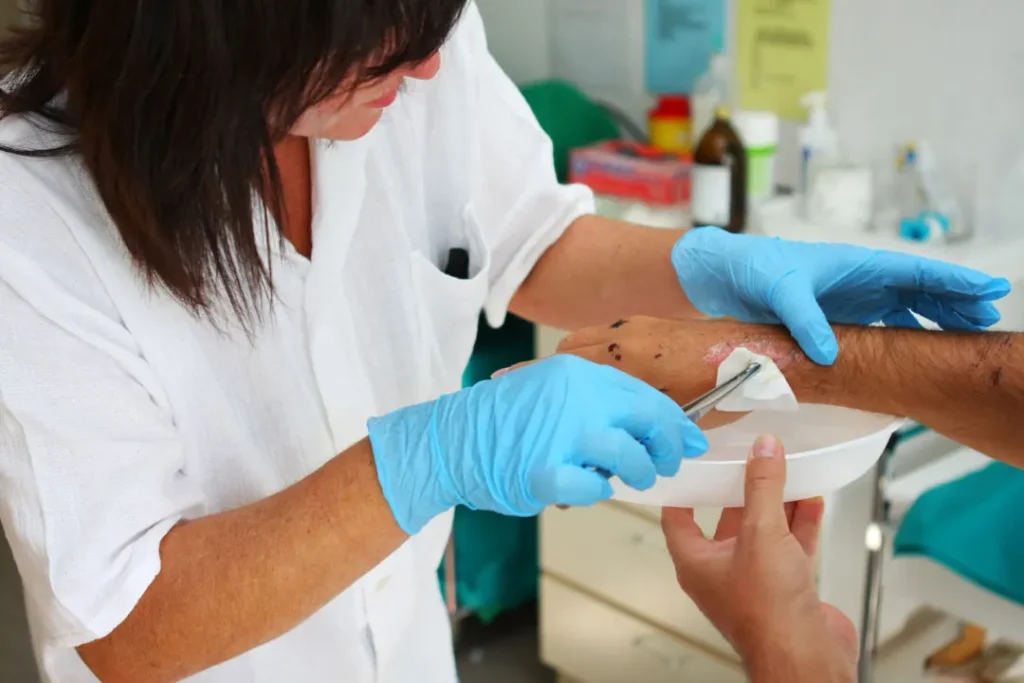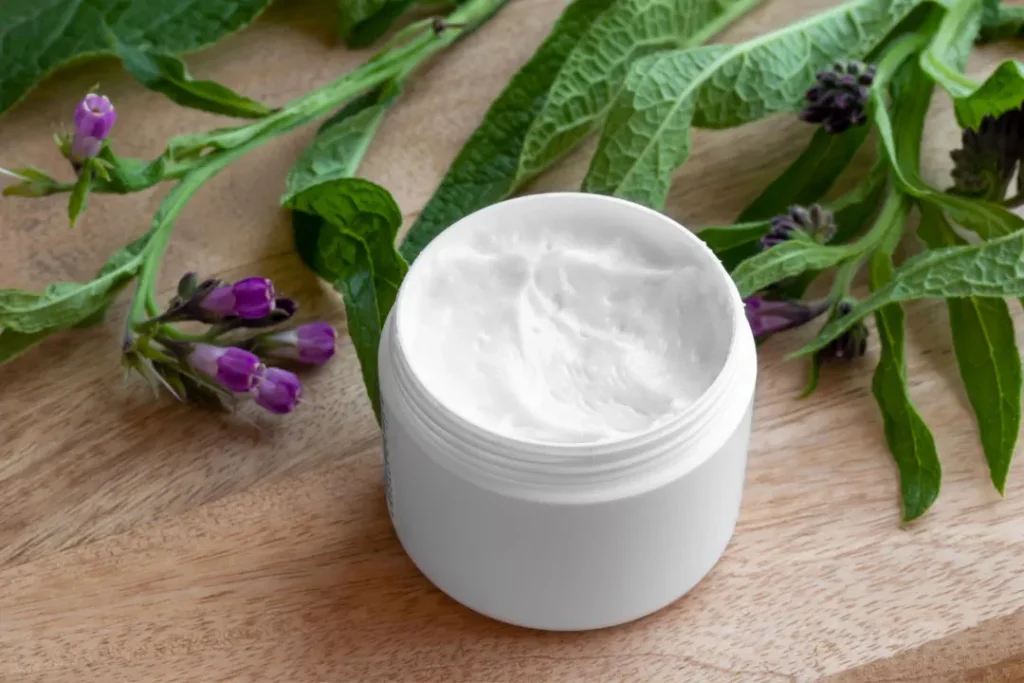Comfrey (symphytum officinale) is a plant prized for its gorgeous bell-shaped blooms and hairy, wide leaves. Native to Europe and parts of Asia, it has historically been used extensively in herbal medicine because of its alleged therapeutic qualities. However, the medical community has grown more worried about its safety. Comfrey’s nature, potential health benefits, ideal dosage, negative side effects, possible drug interactions, and suggestions for its appropriate usage are all covered in this article.
You May Also Like:
Finding the Best Supplements for Brain Fog After COVID: 5 Top Brands Reviewed
What is Non Restorative Sleep? Here are 5 Great Ways to Get Quality Rest Every Night
Comfrey: Benefits, Dosage, Side Effects, Drug Interactions, and Other Important Information is an original (NootropicsPlanet) article.
Nature of Comfrey
Comfrey is a perennial plant belonging to the Boraginaceae family and it grows best in wet, grassy areas. Allantoin, rosmarinic acid, and a variety of pyrrolizidine alkaloids (PAs), including symphytine and echimidine, are among the plant’s complex chemical constituents. Due to their potential therapeutic properties and toxicity issues, these compounds—in particular the PAs—have been the focus of most research.
Health Benefits of Comfrey
Comfrey has been used historically to treat many medical issues. Due to the presence of allantoin, a substance known to increase cell proliferation and aid in wound healing, it has been used most frequently to treat wounds, burns, and sprains.
Rosmarinic acid, a polyphenol found in a variety of plants, is frequently cited as the source of comfrey’s anti-inflammatory benefits. Its inclusion in comfrey is said to help with ailments including arthritis, sprains, and muscular soreness. Additionally, studies suggest that comfrey’s tannin concentration could be a factor in its astringent and anti-inflammatory effects.

Chemistry of Comfrey
The medical benefits of comfrey and its toxicity are significantly influenced by its complex chemical makeup. Allantoin, rosmarinic acid, and numerous pyrrolizidine alkaloids (PAs), including symphytine and echimidine, are among the plant’s many bioactive substances.
A nitrogenous substance called allantoin speeds up wound healing and encourages cell proliferation. The presence of rosmarinic acid, a polyphenolic molecule with anti-inflammatory qualities, helps comfrey to treat ailments including arthritis and muscular discomfort.
When it comes to the chemical composition of comfrey, PAs are the main cause for worry. It is challenging to determine acceptable dosage levels for these alkaloids since they can vary in concentration inside the plant and are possibly hepatotoxic, mutagenic, and carcinogenic.

Physiological Properties of Comfrey
The variety of bioactive chemicals present in comfrey can be credited to the physiological effects it has on your body.
As a cell proliferative agent, allantoin encourages the development of new cells, assisting in the healing process. Allantoin is very helpful in the treatment of wounds, burns, and sprains since it can quicken the cell regeneration process, which can aid in the quicker restoration of injured tissues.
Because of the powerful anti-inflammatory properties of rosmarinic acid, which can also limit the generation of pro-inflammatory mediators, inflammation and discomfort are diminished. Additionally, by scavenging dangerous toxins in the body, its antioxidant qualities help shield cells from oxidative stress.
However, the PAs in comfrey are the ones that provide serious health dangers. In the liver, PAs are converted into pyrrolic derivatives that can bind to DNA and proteins and harm them. Hepatotoxicity and veno-occlusive disease, a disorder marked by the obstruction of tiny veins in the liver, can result from this process. In addition to their mutagenic and carcinogenic properties, PAs can also be hazardous in other ways.
The many physiological processes that comfrey can affect depend on the specific bioactive substances it interacts with. Although it could have certain health advantages, the safety issues raised by its PA content need further research.

Optimal Dosage of Comfrey
A normal dose for comfrey has not been clearly established due to its potential toxicity, which is mostly caused by high PA concentration. The dosages employed in research frequently change and depend on the intended usage. For example, it is typically advised to apply comfrey cream or ointment topically sparingly and for a brief period of time. The amount usually utilized for oral ingestion, which is not encouraged owing to safety concerns, varies widely, and defined doses are unavailable. To prevent any negative effects, it is highly advised that you use comfrey under the direction of your healthcare provider.

Side Effects of Comfrey
The main issue with using comfrey is that it could be harmful because of its PA concentration. The effects of PAs are known to be mutagenic and carcinogenic, and they have been linked to hepatotoxicity (liver damage). While topical administration is typically thought to be safer, it can occasionally result in skin rashes and systemic PA absorption.
Comfrey consumption has been associated to veno-occlusive disease, a disorder in which the tiny veins in the liver get clogged, especially when done over an extended period of time. Damage to or even failure of the liver can result from this blockage.
Potential Substance Interactions with Comfrey
Given that comfrey can be hepatotoxic, interactions with drugs that are processed in the liver might happen. Comfrey can intensify the liver-harming effects of drugs like paracetamol and certain antibiotics, increasing the toxicity of the liver. Comfrey can also interact with anti-inflammatory medications, boosting their benefits due to its putative anti-inflammatory properties.
Responsible Use of Comfrey
It is crucial to approach comfrey usage properly given the safety issues and potential health advantages connected to it. Without the advice of your healthcare provider, it is not advised to consume comfrey, particularly orally. Topical use needs to be kept to a minimum, and any negative side effects must be reported right away to your healthcare professional.
Comfrey:
Conclusion
Although comfrey may have medical use, caution should be exercised when using this herb due to safety issues, particularly its hepatotoxicity. It will be safer to utilize the plant as a medication if more study is done to distinguish between the helpful and dangerous chemicals. Comfrey use should be done cautiously and under your doctor’s supervision at all times. Despite these obstacles, comfrey offers a a compelling case for the potential and pitfalls of medicinal plants.
References:
- Comfrey: A Clinical Overview.link:https://www.ncbi.nlm.nih.gov/pmc/articles/PMC3491633/
- Comfrey has demonstrated healing effects in controlled trials in ankle sprains,8 and even pain-relieving and anti-inflammatory effects.link:https://www.sciencedirect.com/topics/pharmacology-toxicology-and-pharmaceutical-science/comfrey
- Comfrey (Symphytum officinale) is sometimes used on the skin to treat wounds and reduce inflammation from sprains and broken bones.link:https://www.mountsinai.org/health-library/herb/comfrey
Important Note: The information contained in this article is for general informational purposes only, and should not be construed as health or medical advice, nor is it intended to diagnose, prevent, treat, or cure any disease or health condition. Before embarking on any diet, fitness regimen, or program of nutritional supplementation, it is advisable to consult your healthcare professional in order to determine its safety and probable efficacy in terms of your individual state of health.
Regarding Nutritional Supplements Or Other Non-Prescription Health Products: If any nutritional supplements or other non-prescription health products are mentioned in the foregoing article, any claims or statements made about them have not been evaluated by the U.S. Food and Drug Administration, and such nutritional supplements or other health products are not intended to diagnose, treat, cure, or prevent any disease.


